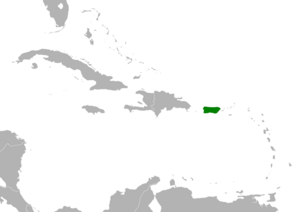Green mango facts for kids
Quick facts for kids Green mango |
|
|---|---|
 |
|
| Conservation status | |
| Scientific classification | |
| Genus: |
Anthracothorax
|
| Species: |
viridis
|
 |
|
The green mango (Anthracothorax viridis) is a type of large hummingbird. It belongs to a group of birds called Polytminae. This special bird lives only on the island of Puerto Rico.
Contents
What Does the Green Mango Look Like?
The green mango hummingbird is about 11 to 14 centimeters (4 to 5.5 inches) long. It weighs around 7 grams (0.2 ounces). That's about the weight of two pennies!
Both male and female green mangoes look very similar. The only small difference is that the female has a tiny white spot behind her eye.
Adult birds have bright emerald green feathers on their upper parts. Their undersides are a shiny blue-green color. Their tail is a metallic blue-black with white tips on its feathers. Young green mangoes have a brownish color on their head and back.
Where Do Green Mangoes Live?
The green mango hummingbird is found only on the island of Puerto Rico. It mostly lives in forests and plant farms in the central and western mountains. These birds are most common at high elevations, usually between 800 and 1200 meters (2,600 to 3,900 feet) above sea level. You won't often see them near the coast.
How Do Green Mangoes Behave?
Moving Around
Green mango hummingbirds move to different heights depending on the season. They follow the blooming of flowers, moving up or down the mountains to find food.
What Do Green Mangoes Eat?
The green mango eats two main things: nectar from flowers and small arthropods (like insects and spiders). They get nectar from many different kinds of flowering trees, bushes, and vines. Male green mangoes will even protect flowering trees from other birds!
They usually catch insects while flying. They also find spiders on leaves and tree bark. These hummingbirds look for food from low bushes all the way up to the tops of tall trees.
Reproduction and Nesting
The green mango's nesting season is from October to May. They build a cup-shaped nest using soft plant fibers. They decorate the outside of the nest with lichen.
The nest is usually attached to a vertical branch, often at least 8 meters (26 feet) above the ground. A female green mango lays two eggs at a time. Scientists don't yet know how long it takes for the eggs to hatch or for the young birds to leave the nest.
What Sounds Do Green Mangoes Make?
Green mango hummingbirds are not very loud birds. They do have a song, which is a repeated high-pitched sound. It starts with a long buzz, like "szzzzz-szi-szi-chup-tsz-tsz....."
Their calls include a short, repeated "tsik" sound and a high-pitched, chattering trill. When they are fighting with other birds, they make harsh rattling and chattering noises.
Is the Green Mango Safe?
The IUCN (International Union for Conservation of Nature) says the green mango hummingbird is a species of "Least Concern." This means they are not currently in danger of disappearing. However, we don't know exactly how many green mangoes there are or if their numbers are changing.
These birds are common in the mountains of Puerto Rico. They also seem to do well in places changed by people, like coffee farms.
See also
- Fauna of Puerto Rico
- List of birds of Puerto Rico
- List of endemic fauna of Puerto Rico
- List of birds of Vieques
- El Toro Wilderness
- Mango Green typically refers to unripe or partially ripe mangoes that are still green in color.


